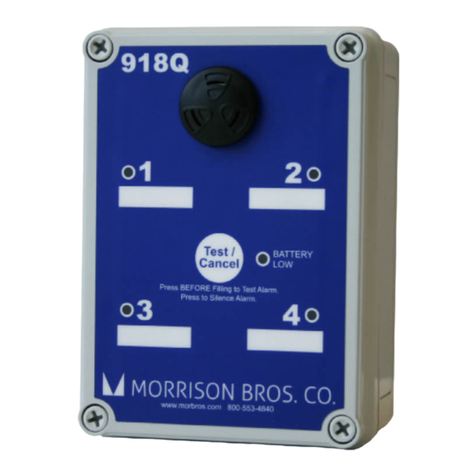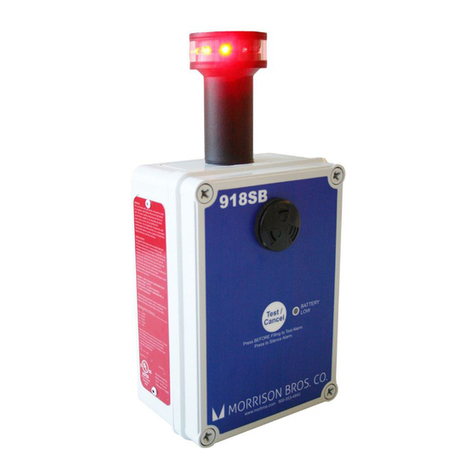
1
Morrison Bros. Co. ‑ Dubuque, IA ‑ 800‑553‑4840
918AC‑0142 PP
!
!
rev.10-20-2021
The 918AC Series is designed to provide a visible and audible alarm. It is an A.C. powered device intended
to be located in an ordinary location. The 918AC Series System Interface is congurable for one to four
Intrinsically Safe, normally open or normally closed, dry contact inputs and from zero to four form C (SPDT),
dry contact outputs. The outputs may be congured as normally disengaged or normally engaged (fail-safe).
Two possible applications are use as an overll alarm or as an interstitial alarm.
Failure to follow any or all of the warnings and instructions in this document could result in a hazardous
liquid spill, which could result in property damage, environmental contamination, re, explosion, serious
injury or death.
Le fait de ne pas se conformer à l’un ou l’autre des avertissements ou à l’une ou l’autre des directives
apparaissant dans ce document pourrait donner lieu à des déversements de liquides dangereux, lesquels
pourraient engendrer des dommages matériels, des risques de contamination environnementale,
d’incendie ou d’explosion, des blessures graves ou la mort.
Contents
Specications.....................................................................................................................................2
Installation and Testing......................................................................................................................3
Mounting ......................................................................................................................................4
Steps to Wire and Congure the System Interface............................................................................5
Input Module(s) ............................................................................................................................5
Facilities Section of the System Interface ....................................................................................7
Output Module(s) (if so equipped) ............................................................................................... 8
Completion ...................................................................................................................................10
Steps to Congure the 918AC Series System Interface Motherboard ..............................................11
Auto-Silence .................................................................................................................................11
Audible Alarm ..............................................................................................................................12
‘Heartbeat’ Function ......................................................................................................................13
Steps to Test the 918AC Series System Interface.............................................................................. 14
Operation ...........................................................................................................................................16
Use as an Overll Alarm ..............................................................................................................16
Use as in Interstitial Alarm ...........................................................................................................16
Maintenance ..................................................................................................................................... 17
Monthly ........................................................................................................................................17
Yearly........................................................................................................................................... 18
DIP Switch Conguration Tables ......................................................................................................19
Input Module ................................................................................................................................19
Output Module..............................................................................................................................19
Motherboard .................................................................................................................................19
Replacement Parts .............................................................................................................................21
918AC System Interface Control Drawing B-7767-14.....................................................................22
918AC Series System Interface
Installation, Operation, and Maintenance Instructions





























